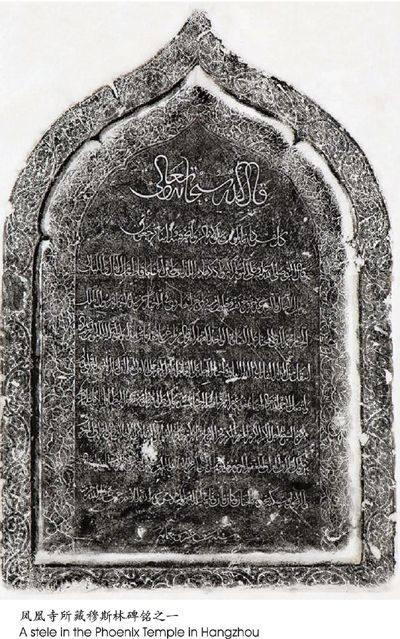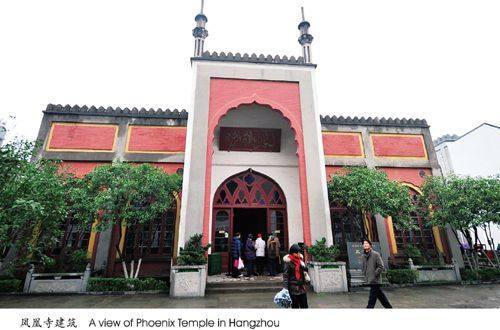释读杭州凤凰寺的“甲骨文”
2012-04-29孙钥
孙钥



2010年底,一场“元代杭州研究论坛”让大家看到了一个“失落在历史烟云中的繁华富丽天堂”。元代杭州,是当时世界上规模最大和最富庶的大都市之一。
2012年夏秋之际,我在杭州文史研究会牵头召开的杭州凤凰寺藏阿拉伯文和波斯文古碑释读评审会上了解到一个新情况:由世界顶尖专家初步转译释读出的铭文显示,早在700年前,杭州已是一座具有高度国际化的大都市。
可是,为什么这批阿拉伯文和波斯文墓碑会出现在杭州?它们的主人是些什么人?又发生过怎样的故事?
杭州文史研究会副秘书长、浙江图书馆教育中心主任吴志坚说,沉睡了700年的古碑,并非一开始就珍藏在凤凰寺。它们最先是在清波门外柳浪闻莺深处的回回塚,那是旧时杭州穆斯林墓地。后来经历波折,才收藏在重建于元代的伊斯兰教清真寺——杭州凤凰寺中。
早在上世纪,这批碑铭就为国际学界所关注,不过一直未能成功释读。难题在于,碑铭上所使用的是特殊的碑铭体,如要释读,并非掌握一般阿拉伯文和波斯文语言知识就可以胜任,而需要高深的专业技能。现今,国际学界有能力释读这种古阿拉伯文和古波斯文碑铭体文字的学者屈指可数。
2008年,杭州文史研究会与英国伦敦大学亚非学院伊朗学系莫尔顿讲师(A.H.Morton)和兰天德博士(Gorge.Lane)合作,着手释读这些碑铭。
古碑的主人是谁?针对这个问题,我请教了南京大学历史系教授刘迎胜。他说,根据铭文显示,在这些墓主中,有波斯人、阿拉伯人、突厥人;其职业,有商人、行省高官、军事官员,以及纯粹的宗教人士;从宗教派别看,有逊尼派、什叶派、苏菲派。他们多从陆路而来,有一位甚至就来自汗八里,即大都,也就是今天的北京。当然,也有个别人士是通过海路而来。墓碑雕刻精美,也充分显示了碑主的社会地位普遍较高。
刘迎胜说,古碑形制为穆斯林式,使用语言为阿拉伯语和波斯语,但许多刻纹却是明显的汉式。这个特征是富有意味的,它反映了当时的穆斯林在顽强保持自己宗教文化传统的同时,也开始受汉文化影响。学者陈垣曾揭示了“西域人”如何“华化”,比如,他们拜汉人为师,参加科举,他们使用汉语吟诗作赋,与汉人士大夫亲密无间。另一方面,他们又身处穆斯林社会,使用祖辈语言,使用阿拉伯语作为宗教语言,使用波斯语作诗,在西子湖边低吟浅唱。“此一浊世,沉浮多少君王与天子的头颅;此世的尘埃,与散发着樟脑与龙涎香气味的秀发与红颜相混。”第14号碑上,这句诗歌的风格意境,竟与我国唐代李长吉的某些诗篇相像。
杭州文史研究会副会长、中国人民大学历史学院教授包伟民说,元代杭州穆斯林与之前来华的穆斯林相比,出现了前所未有的新特征。
唐、宋时的穆斯林聚居于“蕃坊”,多为阿拉伯或波斯商人,沿着海上丝绸之路而来。到了元代,其族源的多元性、社会地位、聚居区繁华程度,都远远高于以往。比如,他们大多从陆路而来,政治地位较高,经济上也比较富裕,且人口繁庶,大商富贾众多。聚居区面积广大,拥有数座清真寺。最古老的一座,就是今天的凤凰寺。而且,还有许多那时的杭州穆斯林聚居区的地名一直沿用至今,比如,“荐桥”也就是今天清泰街一带,还有“回回新桥”“珠宝巷”等。最重要的是,元代杭州的穆斯林聚居区并不是封闭的,它庞大、繁荣,构成了杭州市井生活的重要部分。这也反映了占人口绝大部分的汉人的包容心态。
目前,中国元代穆斯林墓碑分别集中在泉州、扬州和杭州三个沿海城市。泉州墓碑在数量上最多。从内容看,杭州凤凰寺的这批碑铭有着极高的思想性和文学性。“这一批墓碑是中国文化、宗教发展史留下的重要物证,更是古代杭州国际化程度较高的最好证明。它证明在古代相当长的一段时间里,杭州是非常国际化的,其国际化程度与现代相比甚至有过之而无不及。”包伟民说,那是一种既保持某种共同的认同,又宽容而多元的“全球化”。
2011年,莫尔顿不幸因病逝世,但他已完成了将碑铭释成英文的大部分工作。此后,杭州文史研究会延请伊朗德黑兰大学碑铭学专家乌苏吉教授以及国内一流学者通力协作,对照莫尔顿英文原稿,并参校碑铭原文,初步完成碑铭的中译。这项研究集世界顶尖专家通力合作而成,体现了这个领域最前沿的研究成果。
目前,这项工作已完成释读的初稿,这次评审会后,译者将进一步完善译作,争取尽早完稿,目前预计最终的译稿,将是一部包含碑铭图版,波斯语与阿拉伯语原文译文、英文译文以及中文译文合编的学术著作。
(本文摄影:李忠)
Ancient Muslim Tomb Inscriptions Deciphered in
Hangzhou
By Sun Yue
A defining moment of Hangzhou in history crystallized in the 12th century when the Southern Song Dynasty (1127-1279) chose Hangzhou as the capital of the new dynasty. In the Yuan Dynasty (1279-1368), Hangzhou was one of the most prosperous cities in the world, as witnessed and documented by Marco Polo in his memoirs of his epic tour across the oriental country.
Toward the end of August 2012, a symposium, hosted by CPPCC Hangzhou chapter, opened a new page on the history of Hangzhou during the rule of the Mongols. Scholars met to discuss issues on the interpretation of engraved inscriptions on tombstone steles now housed in Phoenix Temple of Hangzhou, an ancient Muslim sanctuary erected in 1281, two years after the Southern Song Dynast fell apart. Top international experts on ancient Persian and Arabic tomb inscriptions as well as Chinese historians attending the symposium agreed that Hangzhou was an international metropolis 700 years ago, as testified by the inscriptions.
In the Yuan Dynasty, Hangzhou became internationalized when people from the West settled down here. Cultures of the Central Asia, Europe and Africa met and merged in Hangzhou. Islam flourished in Hangzhou. The steles at the Phoenix Temple of Hangzhou bear witness to the status Hangzhou enjoyed then as an internationalized city. The local government of today is highly interested in this period simply because the city aims to make itself into an international metropolis again in the 21st century.
In the 20th century, the headstone inscriptions in the Persian and Arabic languages, housed at the Phoenix Temple in Hangzhou, caught the attention of scholars across the world, but no interpretations came forward. The first challenge in reading the tombstone inscriptions was that the inscriptions were written in special ancient Persian and Arabic languages especially configured for tombstone inscriptions and it is said that only a few scholars in the world are able to read the special writing.
It was not until 2008 that Hangzhou Institute for History and Culture Studies worked together with A.H. Morton, a lecturer who taught the Persian at the School of Oriental and African Studies, University of London from 1979 to 1999, and Doctor Gorge Land to read the tombstone epitaphs.
In 2010, the two scholars presented part of their study results at a symposium in Hangzhou on Hangzhou during the Yuan Dynasty. Before he passed away in 2011, Mr. Morton had translated a majority of the epitaphs into English. By the time the lecturer passed away, the restoration of the epitaphs as well as English translation and annotations had been done. Afterwards, a professor with Tehran University, specialized in reading steles and tombstone epitaphs, was engaged to work with Chinese experts to bring the project to completion. Together, they worked out a Chinese version of the epitaphs based on the translation, original texts.
The symposium on August 30, 2012 assessed the finalized work and formulated a plan: Hangzhou is going to publish a research publication composed with photos of these steles, original texts, translations in Chinese and English, annotations, lists of glossaries, references from Bible and Koran. The scholars engaged in the project talked about their work and participating scholars came up with suggestions and comments.
Three highlights of the symposium: best domestic scholars in this field attended; the project results came up to the international level; and the symposium caught the attention of the mainstream media.
The attendees at the symposium agreed that the studies make great contribution to the understanding of the history of Hangzhou as a city and the history of Islam in China. The studies will help people understand the world system in the 13th and 14th centuries from a Chinese perspective. These studies also shed light on the ethnic diversity of the Chinese in ancient China.
